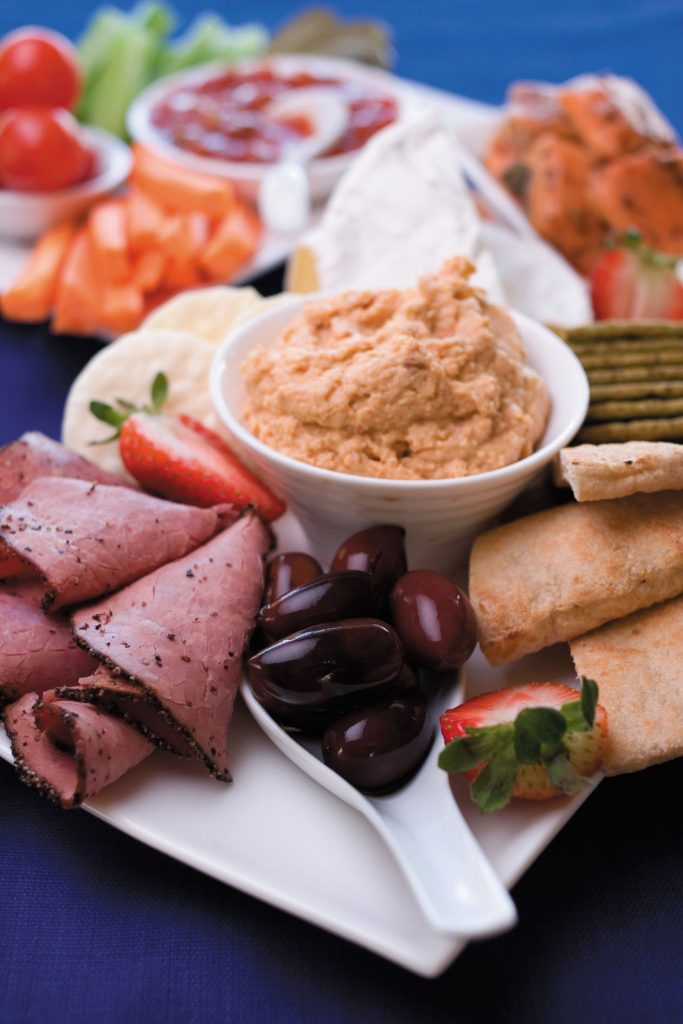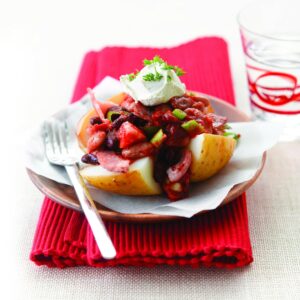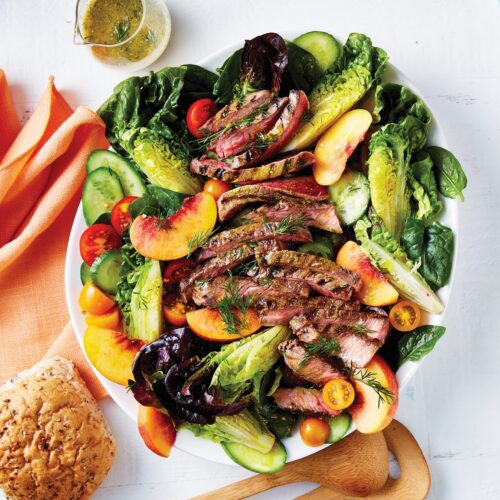

HFG antipasto platter
Ingredients
- 250g tub hummus
- 300g jar tomato salsa
- 125g camembert
- 200g feta, cubed
- 200g pastrami
- 200g hot smoked salmon pieces
- 200g kalamata olives
- 250g gherkins
- 250g cherry tomatoes
- 1 carrot, cut into sticks
- 1 stalk celery, cut into sticks
- 6 individual wholemeal pita breads, cut into small wedges
- 100g rice crackers
- 125g Vita Life Well Grain crackers
Log In or Sign Up to save this recipe to your shopping list.
Instructions
1 Arrange all ingredients on a large platter.
HFG tip
Original ingredients
2 x 250g tubs creamy dip
250g cheddar cheese
250g Swiss cheese
125g camembert
250g salami cubes
250g gherkins
250g corn chips
259g buttery crackers
What we did
Replaced creamy dips with hummus and salsa.
Used pastrami or low-fat salami (or use smoked salmon, smoked oysters or mussels).
Reduced total quantity of cheese and used lower-fat varieties such as reduced-fat cheddar, feta, camembert and brie.
Added lots of different fresh and pickled vegetables (see tips).
Used low-fat rice crackers, low-fat crackers, ciabatta bread, French stick, pita bread etc.
Traditional platter (per serve)
Total energy 2570kJ
Total fat 43g (23g saturated fat)
HFG platter (per serve)
Total energy 1670kJ
Total fat 20g (7g saturated fat)
The ingredients and quantities listed are suggestions only. What and how much you serve depends on many factors, including time, availability, personal preference and cost. Follow these tips for keeping your platters healthy.
Make your platter colourful. Since colour comes mainly from fruit and vegetables, colourful platters are likely to be better for us. A platter that is mainly yellow and brown is likely to high in fat and kilojoules and not so rich in the nutrients essential to well-being.
Have a variety of foods. Platters based around cheeses and fatty dips provide little choice for those watching their health or weight. Providing a variety of foods and ensuring there are healthy, low-kilojoule choices ensures there is something for everyone and shows you are looking after your guests’ physical as well as social well-being!
Limit cheeses and choose lower-fat varieties. Cheeses can be part of your platter, but not the dominant feature. Use edam, feta, camembert, brie or reduced-fat cream cheese since these are lower in fat than traditional platter favourites such as triple cream soft cheeses, cheddar and creamy blues.
Replace creamy dips with hummus, salsa or other low-fat dips. If a dip is based on cream cheese or sour cream, it is bound to be high in fat and kilojoules. Instead choose lower-fat alternatives such as hummus, baba ganouj, salsa and tsatsiki. As well as being lower in fat, they are richer in essential nutrients.
Include vegetables. Go for different coloured varieties as different colours mean different nutrients are present. Vegetables can be fresh, dried or pickled. Ideas include: cherry tomatoes, olives, gherkins, caper berries, artichokes, carrot sticks, snow peas, celery, avocado or cucumber.
Include seasonal fruit. Fruit such as cherries, strawberries, raspberries, melons, grapes, mangoes and pineapple are at their best. They add wonderful colour and flavour to a platter.
Think beyond potato chips and corn chips. They are high in fat, salt and kilojoules and are easy to over consume. Instead use lower-fat/lower-salt versions or rice crackers. Rice crackers have the added advantage of being suitable for people on gluten-free diets; very often we forget that there are a lot of people in this category.
Choose crackers wisely. Many believe that because crackers are savoury, they are a healthy choice and something to eat freely. This unfortunately is not the case. Crackers come in many varieties and some are far from healthy. A good judge is mouth feel; if the cracker tastes buttery and has a smooth, melt-in-the-mouth texture, it is probably high in fat and kilojoules. Such crackers are often high in salt as well, which will trigger the thirst mechanism and make it more likely that you will drink more alcohol. As a general rule of thumb choose grainy, non-salty and crunchier crackers and check the labels for fat and salt content. Ideally choose crackers with less than 10g fat and more than 5g fibre per 100g.
Include bread. Slices of French stick, foccacia or pita bread pieces provide bulk to a platter and go well with the other food items. They have the added advantage of filling people up cheaply and healthily.
Nuts are good but don’t go crazy on them. Nuts are high in fat but the fats they contain are good for our health. Being high in fat makes them high in kilojoules, unfortunately, so they are not something we can eat freely. Around 30g of nuts per day is a standard recommendation for health. This is a very small quantity (about a child’s handful), and far less than most of us would eat when standing around with a drink and a ready supply on hand. If you want to include nuts, provide unsalted varieties in small quantities with a variety of other foods.
Use more of the cheaper ingredients to keep costs down. Ingredients such as smoked salmon, pastrami and good quality olives can bump up the price of a platter. To keep costs down, have smaller quantities of expensive ingredients and bulk out with bread, crackers and cheaper fruits and vegetables. Take advantage of supermarket specials on dips and cheeses.
Nutritional comment
Since platters vary so much in content and since people eat different combinations of foods from them, it is impossible to provide accurate nutritional comparisons per serve between the healthy and not-so-healthy platters. By introducing the changes listed here, however, you can be reassured that you will make it easier for your guests to consume foods that have good nutritional balance (lower sat fat, lower kilojoule, higher fibre and more vitamins and minerals).
Nutrition Info (per serve)
-
Calories 399 cal
-
Kilojoules 1670 kJ
-
Protein 0 g
-
Total fat 20 g
-
Saturated fat 7 g
-
Carbohydrates N/S
-
Sugar N/S
-
Dietary fibre 0 g
-
Sodium N/S
-
Calcium N/S
-
Iron N/S
© Healthy Food Guide All rights reserved. Reproduction without written permission prohibited.
Sign up for the  newsletter
newsletter
Delicious recipes and expert health advice you can trust, delivered to your inbox.
More recipes you may like
Makeover recipes
Advertisement
Snacks and Light Meals
Advertisement
Advertisement
RELATED ADVICE LATEST ADVICE













